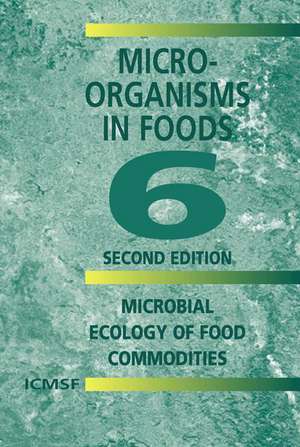Microorganisms in Foods 6: Microbial Ecology of Food Commodities
en Limba Engleză Hardback – iul 2005
Preț: 2014.96 lei
Preț vechi: 2457.27 lei
-18% Nou
385.58€ • 412.30$ • 321.47£
Carte tipărită la comandă
Livrare economică 18 aprilie-02 mai
Specificații
ISBN-10: 030648675X
Pagini: 763
Ilustrații: XVI, 764 p.
Dimensiuni: 178 x 254 x 41 mm
Greutate: 1.6 kg
Ediția:2nd ed. 2005
Editura: Springer Us
Colecția Springer
Locul publicării:New York, NY, United States
Public țintă
ResearchCuprins
Preface/Introduction.- Meat and meat products.- Poultry and poultry products.- Fish and fish products.- Feeds and pet foods.- Vegetables and vegetable products.- Fruits and fruit products.- Spices, dry soups and oriental flavourings.- Cereals and cereal products.- Nuts, oilseeds and dried legumes.- Cocoa, chocolate and confectionery.- Oil-based and fat-based foods.- Sugar, syrups, and honey.- Soft drinks, fruit juices, concentrates and fruit preserves.- Eggs and egg products.- Milk and dairy products.- Preventing abuse of foods after processing.
Textul de pe ultima copertă
The second edition of Microorganisms in Foods 6: Microbial Ecology of Food Commodities is intended for those primarily in applied aspects of food microbiology. For 17 commodity areas it describes the initial microbial flora and the prevalence of pathogens, the microbiological consequences of processing, typical spoilage patterns, episodes implicating those commodities with foodborne illness, and measures to control pathogens and limit spoilage. The control measures are presented in a standardized format in line with international developments in risk management. A comprehensive index has also been added.
Microorganisms in Foods 5, 7, and the second edition of Microorganisms in Foods 6 are for anyone using microbiological testing and/or engaged in setting Microbiological Criteria, whether for the purpose of Governmental Food Inspection and Control or in Industry, and for those identifying the most effective use of microbiological testing in the food chain. The contents are essential reading for food processors, food microbiologists, food technologists, veterinarians, public health workers and regulatory officials. For students in Food Science and Technology they offer a wealth of information on Food Microbiology and Food Safety Management, with many references for further study.
The information has been prepared by the International Commission on Microbiological Specifications for Foods (ICMSF). The ICMSF was formed in response to the need for internationally acceptable and authoritative decisions on microbiological limits for foods moving in international commerce. Currently the membership consists of eighteen food microbiologists from eleven countries, drawn from governmental laboratories in public health, agriculture, and food technology, from universities and from the food industry.
Caracteristici
Descriere
Covering 17 commodity areas, this work describes the initial microbial flora and the prevalence of pathogens, the microbiological consequences of processing, typical spoilage patterns, episodes implicating those commodities with food borne illness, and measures to control pathogens and limit spoilage. It also includes a comprehensive index.
